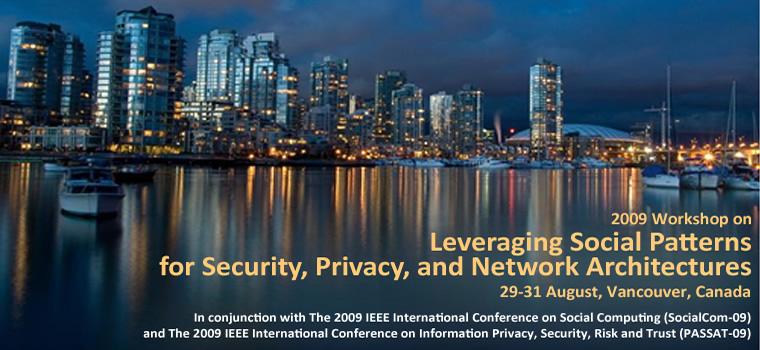About the Workshop
Most existing communication network architectures are agnostic to the structures and behaviors of the human networks that they serve. By incorporating social patterns into the network protocols we might be able to significantly improve the network security, privacy and quality of service levels, by producing protocols that are auto-adaptive to the social aspects of their users’ network behaviors. Utilization of social information at the networking layers could facilitate the building of systems and applications of higher reliability, efficiency, and usability.
Recent years have seen an explosion of social applications on the Internet. However, most of these works remain at the end-user and application levels: applications that reside within specific websites like Facebook, or ones that link social information between other applications - like instant messaging, blogs, web browsers or email clients. Aside from nascent work on areas such as routing and security filters, so far few have ventured into taking the social information down to the lower layers of the network stack.
The workshop aims to bring to the forefront two intertwined approaches that involve the use of social information and social modeling for networking, privacy and security applications:
(1) Creation of network architectures and network devices that are aware of the interpersonal networks and relationships of the end-users.
(2) Designing network architectures that are inspired by the way human networks and human society operate.
For a more detailed overview and motivation for the workshop, please see this link.
Areas of Interst
This workshop invites submissions related (but not limited) to the following topics:
- Socially inspired network architectures
- Integrating social information with traditional network layers: Integrating with the OSI model, cross-layerd approaches, etc.
- Socially aware network protocols
- Configuring protocol parameters based on social information - Like TCP/IP settings, authentication, QoS
- Socially aware architectures for the home and office environment
- Security configuration based on social contexts groups (social-firewall, authentication protocols, etc.)
- Opportunistic and ad-hoc communications (e.g. interacting with strangers)
- Diffusion/routing protocols - using the human social network (delay tolerant networks/"pocket switched networks"/"sneaker nets")
- Interest based protocols (selective information dissemination, profile-based multicasting)
- Algorithms inspired by human social interaction
- Social awareness in physical, link. and MAC layers
- Providing security and privacy for social overlay networks
Workshop Goals
The guiding goal of the workshop is to bring together researchers and practitioners who deal with social modeling and social data collection side by side with those who design communications algorithms and protocols, in order to:
(1) Survey and discuss the current state of research that deals with using social information and social awareness in core areas of data networking and security.
(2) Debate different approaches for integrating social information with existing and future network architectures.
(3) Foster creativity and imagine the underlying technological changes in the way we network and communicate that will take place over the next 5-10 years.
(4) Develop a strategy for creating a community of researchers and practitioners who are interested in ways for enabling current network layers to incorporate social models, behaviors, structures and dynamics.
(5) Create new opportunities and set the ground for future collaboration between participants, generating insights that can be carried forward into future work.
